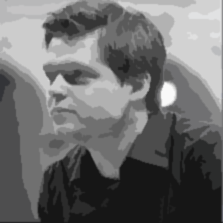Ionarts at Large: Martin Grubinger Beats it All
An extraordinarily attractive concert of the Munich Philharmonic promised the titillating combination of Arvo Pärt’s “Cantus in memoriam Benhamin Britten”, James MacMillan’s percussion concerto “Veni, Veni, Emmanuel”, and Shostakovich’s fifteenth and last Symphony – surely an underrated work in his admittedly uneven symphonic canon. All was to be conducted by the splendid Jonathan Nott who has much to do with the resurgence of the Bamberg Symphony.
Following hot on the heels of James MacMillan’s conducting his own “Vigil”, this would have been a fine opportunity to get repeat exposure to one of the most important of the reasonably accessible yet uncompromising composers of our time. It would also have fit nicely into the laudable effort by the Munich Philharmonic to give its very ‘central European’ audience the opportunity to experience Anglophone classical music on a regular basis this season: Next to said (and the planned) MacMillan also the Violin Concerto and War Requiem of Benjamin Britten and – just last week – Thomas Adès’ “Asyla”.
Alas, it was Nott to be, and with the young Slovakian conductor Juraj Valcuha (US debut in 2007 with the Pittsburgh Symphony Orchestra) replacing the Britt, the program changed entirely. Mozart’s overture to “Le Nozze di Figaro” was now followed by Avner Dorman’s percussion concerto “Frozen in Time” and Maurice Ravel’s “Daphnis et Chloé” replaced the biting, yet lithe, Shostakovich symphony so full of odd humor, bitterness, and resignation.
I cannot be blamed for (initial) disappointment, made worse by my lamentable deficiency to find in Ravel’s piece – whether the whole thing or the two suites as performed here (without the chorus) – anything more than mildly enjoyable, usually boring. It’s an oddly evocative, subdued, and misty piece… dotted with martial bursts of vigor and joy, and it can splendidly show off an orchestra’s ability for color. But played at anything less than total commitment I find it a damp squib.
 M.Ravel, F.Poulenc, Daphnis et Chloé, Les Biches M.Gielen, M.Viotti / SWR SO, EuropaChorAkademie hänssler CLASSIC      A.Dorman, Piano Sonatas Eliran Avni Naxos     |
(Daphnis et Chloé was of course conceived as a 'soundtrack' to one of Serge Diaghilev’s “Ballets russes” which are responsible for so many of today’s well known classical hits - and some less known ones.)
The Mozart overture was engaged and explosive, as if the lessons the Orchestra took to heart from Thomas Hengelbrock the month before (Mozart and Schumann with Ramón Vargas) has still been present.
The real firecracker – and one that went off in all directions – was the Dorman Percussion Concerto. Just like there was a time where every avant-garde composer felt compelled to write a piece for solo flute, there is now a worrisome influx of percussion concertos from modern – usually tonal – composers. Even orchestral pieces without the appropriate warning label are often completely taken over by percussion batteries hammering away at will. This was, fortunately, a positive exception to the syndrome of extra bongos making up for lack of inspiration.
The Israeli-American Avner Dorman, born in 1975, was only known to me through a Naxos release of his piano music that I found “damn good” two years ago. Last season his “Variations Without a Theme” were premiered with the Nashville Orchestra (conducted by the secretly-superb Asher Fisch). “Frozen in Time” was commissioned by the young Austrian percussion wizard Martin Grubinger who premiered the work just two months ago in Hamburg and now presented it in Munich.
Grubinger was the very image of a little boy who, with unbridled joy and enthusiasm, red cheeks and a shock of obstinate blond hair, got to work on his noise-toy that had been built around him on all four sides like a little play castle. In three movements he charmed the dead-serious audience to appreciate and enjoy the humor and exhilaration of the concerto. “Indoafrica”, the first movement, is dominated by wooden sounds and organic shapes, and emphasized the marimba skills of Grubinger, the youngest finalist of the 2nd World Marimba Competition in Okaya (winner was MSU professor Gwendolyn Burgett Thrasher).
“Eurasia” is of a northern, metallic character. Extraordinary delicate and melodic moments, downright pretty (Mozart, by the composer’s own admission, never far away), and making much use of small Tibetan bells. Meditative parts with a prominent solo violin and more metallic plink dominate. The mechanical character of “The Americas” moves away from the multi-cultural ethnic and possibly ancient sounds that may well be “frozen in time” and arrives straight in the urban landscapes of America. Those who wish can hear tango and Afro-Cuban Jazz here – I heard reminders of Antheil and Varèse.
A stunning virtuoso feast of an encore (a work for a Pinzgau drum by Grubinger himself) had the audience in ecstasy: Drums, percussion – when well done – appeal to something deep within us… even deep within the most fun-and-joy-resistant European concertgoer. The inner aversion to all things frivolous caves before aboriginal, deep-seated responses to rhythm.
So they did, here.
























































